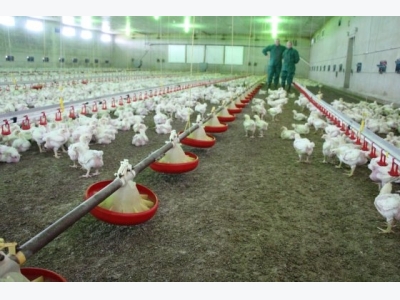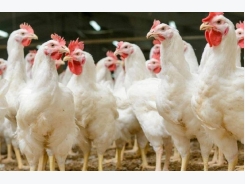Natural coccidiosis prevention concept

Research shows that it's possible to partially, and in some cases even completely, produce broilers using coccidiostat free feed. A field trial with a natural coccidiosis prevention concept shows really promising results.
One of the German broiler farmers who participated in the research field trials is Andreas Moorkamp (46) from Gehlenberg, Germany. He has a total of 200,000 broilers. Photo: Dick van Doorn
Worldwide the poultry industry is annually spending significant amounts of money on the prevention and treatment of coccidiosis, caused by the Eimeria species. The protozoan parasite invades the intestinal wall and starts to reproduce, damaging gut tissue, causing poor digestion and nutrient absorption. Depending on the Eimeria species involved, this takes place in different parts of the intestine, in all cases causing economic loss to poultry producers. For coccidiosis prevention, poultry farmers clean and disinfect houses, use coccidiostats in diets or vaccinate birds.
Olus Plus from Hasselt, in the Netherlands is a supplier of animal health products and innovative animal feed supplements. In recent years the company developed the TriOlus concept allowing poultry farmers to feed partially or completely coccidiostats free feed. This new concept for poultry with the goal to allow commercial poultry a natural, mild coccidiosis infection in order to build immunity without adverse effects on health and production performance. With the programme broilers are fed Elan Biotic from day 0 – 13, Necotyl from day 14 – 27 and Elan Plus from day 28 – 42 Elan in respectively starter, grower and finisher diets with a dosage rate of 600 grams per ton of feed. The three products contain specific combinations of herbal extracts, essential oils and organic acids that are matched to the appropriate life stage of the broiler supporting a balanced intestinal flora and tissue integrity during the different stages of the production cycle.
Lower risk of resistance
The concept has been developed by the Olus Plus research team at the R&D centre in Schuinesloot, the Netherlands. This was done in collaboration with the Department of infectious diseases and Immunology – Clinical Infectiology at the University of Utrecht and nine German and Dutch broiler farmers. The initial research into alternatives for the control of coccidiosis started in 2008 in calves. This resulted in an innovative technology Solucox for treatment and prevention of coccidiosis and Cryptosporidium in calves. Soon after the first successes and excellent feedback from farmers and veterinarians using Solucox to treat coccidiosis in calves, the Olus Plus research team started examining the possibilities for developing a concept to prevent coccidiosis in broilers. In order to control avian coccidiosis, anti coccidial drug concepts have been developed and became available for the poultry farmer during the last 50 years.

The results in the concept fed house are the same compared to the control house with the coccidiostat programme. Photo: Dick van Doorn
However, alternative plant derived product concepts with anti coccidial effects have entered the market as well. In our drive to develop sustainable concepts there is a general belief that natural plant derived solutions have a lower risk of developing resistance. The modern hybrids currently used in poultry production do have a completely different genetic profile and performance potential compared to their ancestors. To turn this potential into top performance in the field, the use of latest nutrition and health technology is of crucial importance. “The trigger for the development of the TriOlus concept for broilers was a European broiler integration that indicated that they found it difficult to eventually produce broilers with coccidiostats free feed,” said Olus Plus Director Johannes Fuite.
Field trails
After extensive lab research, the first trials with the TriOlus concept at German and Dutch broiler farms started in 2014. The products were initially fed in addition to a complete broiler feed with a traditional coccidiostats programme. The good practice results gave confidence and in the beginning of 2015 the research team decided to use also the concept as a complete replacement of coccidiostats in broiler feed. A total of nine broiler farmers participated during three or four cycles in this field trial. In addition to the control group (house) with a traditional coccidiostats programme in the feed, the farmer used the combination coccidiostat/Necotyl, or the combination coccidiostat/Necotyl/Elan Plus in the treatment group (house). One farmer completely replaced the coccidiostats programme for the full TriOlus programme.
The results (see table) show that the technical performance of the three pilot groups are at least on the same level compared with those of the control group. The corrected feed conversion 1500 gram tended to be lower, the production number higher.
The first, preliminary research results with the products in conjunction with a common coccidiostats programme see positive effects on technical results, but also on broiler gut health. This will be apparent from morphological research by the University of Lviv (Scientific Production and Consulting Center) in Ukraine. Broilers which were fed according to the programme showed increased intestinal villi length. This means a larger intestinal surface and therefore more absorption capacity.
Table - Trial results: triolus concept vs coccidiostats.
| Chicks placed | Deadloss (%) | Age days | Slaughter weight grammes | ADG grammes/ day | FCR | FCR1500 | EPF | |
| Coccidiostat | 970,100 | 2.3 | 38.7 | 2232 | 57.5 | 1.637 | 1.344 | 343 |
| Coccidiostat + NT/EP | 608,600 | 2.25 | 38.3 | 2367 | 61.4 | 1.611 | 1.264 | 373 |
| TriOlus (EB/NT/EP) | 141,000 | 1.84 | 38 | 2169 | 57 | 1.559 | 1.296 | 359 |
| Coccidiostat | 141,000 | 1.5 | 36.6 | 2014 | 55.1 | 1.544 | 1.338 | 352 |
| TriOlus (EB/NT/EP) | 141,000 | 1.84 | 38 | 2169 | 57 | 1.559 | 1.296 | 359 |
Search for best combination
One of the German broiler farmers who participated in the research field trials is Andreas Moorkamp (46) from Gehlenberg, Germany. He has a total of 200,000 broilers. To compare performance, he fed the common coccidiostat programme (Maxiban - Sacox) in one group (house) as control and fed the full TriOlus programme without coccidiostats in the neighbouring house as the treatment group. Ross 308 chicks were used and the design of both stables identical. Moorkamp: “I've used the concept completely replacing the coccidiostat programme in one house for four rounds since October 2015 now, and that goes very well. The results in the concept fed house are the same compared to the control house with the coccidiostat programme. The cost of the concept is about €0.01 per broiler, similar to the costs of a coccidiostat programme.”

A field trail in The Netherlands shows that it is a viable strategy to replace in feed coccidiostats with a natural prevention concept. Photo: Dick van Doorn
Because the German broiler farmer is normally alternating his standard coccidiostat programme, the fifth cycle is currently on Deccox, aiming to reduce the number of oocysts on his farm. Moorkamp: “I'm excited about the first results with the use of the concept to control coccidiosis on my farm. The question is however, how will this work in practice in the long term. Coccidiosis is a persistent farm problem.” Hence Moorkamp in consultation with Olus Plus is reviewing options to run the next cycles with just the full TriOlus concept again, or using a combination coccidiostat/TriOlus. “Of course I'm going for the best technical results. An investment of €0.01 per broiler is quickly recovered.”
Eimeria oocysts count and differentiation
On the Moorkamp farm manure samples were collected every three – four days from the control and treatment group (house) as from 16 days of age. The University of Utrecht counted the numbers of oocysts per gram (OPG) and typed various Eimeria species. Results from two cycles have not been published yet, said Wim Beeks, product manager at Olus Plus. Beeks: “In cycle one, we see in both the control as in the treatment group that the number of oocysts peak at around 21 days of age. The number of oocysts in the group with the concept is 300,000, in the house with the coccidiostat programme 400,000. In cycle 2 OPG started to increase in both houses at the same time (day 21), in the control house OPG peaked later at day 28 compared to day 24 for the treatment house. OPG remained at a high level for a remarkably longer period in the house with the coccidiostat programme compared to the concept fed house. With respect to the population composition, in both studies (cycle one and two) and in both groups (houses) Eimeria acervulina dominated the OPG during the third and fourth week in the production cycle at the peak OPG levels. At 16 days of age both groups showed an average of 43% Eimeria Acervulina, at day 21 this increased to on average 75% of the total. In the control group the percentage of Necatrix/Praecox was 47% at day 16 compared to 17% of the total in the TriOlus group. Towards the end of each cycle when OPG decreased and became low, Eimeria Maxima was the dominant species.
Tremendous interest
Coccidiosis is an important issue within the international poultry industry. Hence, some 90% of worldwide poultry farmers use coccidiostats in the feed to prevent and control infections. With the concept Olus Plus aims to contribute to the reduction and spread of coccidiosis and to the improvement of gut health in a sustainable poultry production chain. There is worldwide interest in the concept as an addition or as a possible alternative to the usual coccidiostats programmes. Broiler farmers in Germany, Poland, the Netherlands, Belgium and Ukraine fit the concept or parts thereof already in broiler diets or drinking water. Trials will start shortly in Italy, Hungary, Switzerland and Norway. Also the Brazilian poultry industry has shown interest.
Fuite: “In addition to the results we have collected in our own research centre and the collaborating universities, we are closely following the users in the field in order to develop an even better picture. Broiler performance in the field shows that the three phase concept is well balanced and that the individual products each are adding a plus to broiler flock performance.” The Olus Plus research team is currently working on the development of a programme to control coccidiosis in turkey production and layer rearing.
Related news
Tools

Phối trộn thức ăn chăn nuôi

Pha dung dịch thủy canh

Định mức cho tôm ăn

Phối trộn phân bón NPK

Xác định tỷ lệ tôm sống

Chuyển đổi đơn vị phân bón

Xác định công suất sục khí

Chuyển đổi đơn vị tôm

Tính diện tích nhà kính

Tính thể tích ao




 Challenges and solutions in coping with poultry red…
Challenges and solutions in coping with poultry red…  Avian flu persists in Europe’s top poultry raising…
Avian flu persists in Europe’s top poultry raising…